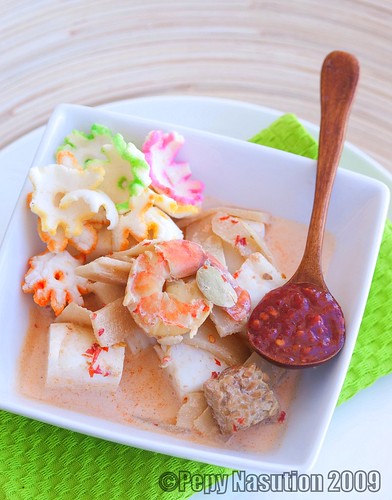
Disclaimer: Asam padeh tongkol comes with medium amount of reddish mixture liquid. Don't do what I have done, mine was too dry. I left the kitchen and almost forgot with my cooking. :)
With the richness of spice and bright red colour, asam padeh is one of typical Western Sumatran (Minangese) dishes that I relish. Thanks Uni. The recipe has the same taste as I had the last time while I was still at my parent's house.
Asam kandis (Garcinia xanthochymus) and turmeric leaves are types of spices in Minangese dish. Due to the lack of ingredients, I modified this recipe by using kokum or kokam (Garcinia indica) which is popular in Western India culinary. For some people who familiar with South India culinary such as Kerala, kodampuli (Garcinia gummi-gutta) can be used as substitution. Asam kandis, kokum/kokam, kodampuli Kokum or kokam Kokum are belong to the same family of Garcinia or mangoosteen family, so they can be used interchangeably.
Asam Padeh Tongkol
recipe by Dewi Anwar, modified by me
Ingredients
a whole skipjack tuna (about 500 g) ==> this had been scaled
3 tbsp squeezed calamansi juice*original recipe used lime juice
olive oil for stir frying
water
Spices (non-grinding)
3 pieces kokam/kokum *original recipe used asam kandis
2 bilimbi (Indonesian: belimbing sayur) *original recipe didn't add ones
5 cm long galangal, bruised
2 lemongrasses, take the white parts and bruised
3 Indonesian bay (salam) leaves
3 kaffir lime leaves, teared
1 turmeric leaf, teared ==> can be substituted for curry leaves (Indonesian: daun salam koja or daun kari)
2 cardamom
Spices grind into a paste:
300 g ground red chili peppers ==> can be substituted for sambal ulek
8 shallots
5 cloves garlic
5 cm long ginger
2 candlenuts
salt as desired
Directions:
1. Clean the stomach cavity, remove the gills and surrounding tissue. Cut into pieces. Drizzle calamnsi over and set aside.
2. In a medium-hight heat, stir fry non-grinding ingredients and paste spices until fragrant. Add water and cool until boiling and the liquid thicken.
3. Add skipjack tuna, reduce the heat to low and cook until fish done and the liquid has evaporated. Taste to perfection and remove from heat.

